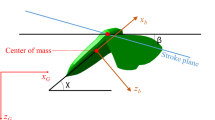Abstract
The effects of corrugation and wing planform (shape and aspect ratio) on the aerodynamic force production of model insect wings in sweeping (rotating after an initial start) motion at Reynolds number 200 and 3500 at angle of attack 40° are investigated, using the method of computational fluid dynamics. A representative wing corrugation is considered. Wing-shape and aspect ratio (AR) of ten representative insect wings are considered; they are the wings of fruit fly, cranefly, dronefly, hoverfly, ladybird, bumblebee, honeybee, lacewing (forewing), hawkmoth and dragonfly (forewing), respectively (AR of these wings varies greatly, from 2.84 to 5.45). The following facts are shown. (1) The corrugated and flat-plate wings produce approximately the same aerodynamic forces. This is because for a sweeping wing at large angle of attack, the length scale of the corrugation is much smaller than the size of the separated flow region or the size of the leading edge vortex (LEV). (2) The variation in wing shape can have considerable effects on the aerodynamic force; but it has only minor effects on the force coefficients when the velocity at r 2 (the radius of the second moment of wing area) is used as the reference velocity; i.e. the force coefficients are almost unaffected by the variation in wing shape. (3) The effects of AR are remarkably small: when AR increases from 2.8 to 5.5, the force coefficients vary only slightly; flowfield results show that when AR is relatively large, the part of the LEV on the outer part of the wings sheds during the sweeping motion. As AR is increased, on one hand, the force coefficients will be increased due to the reduction of 3-dimensional flow effects; on the other hand, they will be decreased due to the shedding of part of the LEV; these two effects approximately cancel each other, resulting in only minor change of the force coefficients.
Similar content being viewed by others
References
Ellington, C.P.: The aerodynamics of hovering insect flight. I. Quasi-steady analysis. Phil. Trans. R. Soc. Lond. B, 305, 1–15 (1984)
Ellington, C.P., Van Den Berg, C., Willmott, A.P.: Leading edge vortices in insect flight. Nature 384, 626–630 (1996)
Liu, H., Ellington, C.P., Kawachi, K., Van Den Berg, C., Willmott, A.P.: A computational fluid dynamic study of hawkmoth hovering. J. Exp. Biol. 201, 461–477 (1998)
Dickinson, M.H., Lehman, F.O., Sane, S.P.: Wing rotation and the aerodynamic basis of insect flight. Science 284, 1954–1960 (1999)
Sun, M., Tang, J.: Unsteady aerodynamic force generation by a model fruit fly wing in flapping motion. J. Exp. Biol. 205 55–70 (2002)
Wu, J.H., Sun, M.: Unsteady aerodynamic forces of a flapping wing. J. Exp. Biol. 207, 1137–1150 (2004)
Rees, C.J.C.: Aerodynamic properties of an insect wing section and a smooth aerofoil compared. Nature 258, 141–142 (1975)
Kesel, A.B.: Aerodynamic characteristics of dragonfly wing sections compared with technical aerofoils. J. Exp. Biol. 203, 3125–3135 (2000)
Usherwood, J.R., Ellington, C.P.: The aerodynamics of revolving wings. I. Model hawkmoth wings. J. Exp. Biol. 205, 1547–1564 (2002)
Usherwood, J.R., Ellington, C.P.: The aerodynamics of revolving wings. II. Propeller force coefficients from mayfly to quail. J. Exp. Biol. 205, 1565–1576 (2002)
Zanker, J.M.: The wing beat of Drosophila melanogaster. I. Kinematics. Phil. Trans. R. Soc. Lond. B 327, 1–18 (1990)
Rees, C.J.C.: Form and function in corrugated insect wings. Nature 256, 200–203 (1975)
Norberg, RA: The pterostigma of insect wings an inertial regulator of wing pitch. J. Comp. Physiol. 81, 9–22 (1972)
Ellington, C.P.: The aerodynamics of hovering insect flight. II. Morphological parameters. Phil. Trans. R. Soc. Lond. B 305, 17–40 (1984)
Ellington, C.P.: The aerodynamics of hovering insect flight. III. Kinematics. Phil. Trans. R. Soc. Lond. B 305, 41–78 (1984)
Sun, M., Xiong, Y.: Dynamic flight stability of a hovering bumblebee. J. Exp. Biol. 208, 447–459 (2005)
Sun, M., Wu, J.H.: Aerodynamic force generation and power requirements in forward flight in a fruit fly with modeled wing motion. J. Exp. Biol. 206, 3065–3083 (2003)
Wu, J.C.: Theory for aerodynamic force and moment in viscous flow. AIAA Journal 19, 432–441 (1981)
Author information
Authors and Affiliations
Corresponding author
Additional information
The project supported by the National Natural Science Foundation of China (10232010 and 10472008) and Ph. D. Student Foundation of Chinese Ministry of Education (20030006022)
The English text was polished by Keren Wang.
Rights and permissions
About this article
Cite this article
Luo, G., Sun, M. The effects of corrugation and wing planform on the aerodynamic force production of sweeping model insect wings. ACTA MECH SINICA 21, 531–541 (2005). https://doi.org/10.1007/s10409-005-0072-4
Received:
Revised:
Accepted:
Published:
Issue Date:
DOI: https://doi.org/10.1007/s10409-005-0072-4



